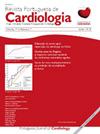斯坦福a型主动脉夹层患者术后急性呼吸窘迫综合征预测图的建立:一项回顾性研究。
IF 1.6
4区 医学
Q3 CARDIAC & CARDIOVASCULAR SYSTEMS
引用次数: 0
摘要
简介和目的:本回顾性研究旨在建立一种预测Stanford a型急性主动脉夹层患者术后急性呼吸窘迫综合征(ARDS)风险的nomogram方法。方法:该研究包括在2020年1月至2023年12月期间接受斯坦福A型急性主动脉夹层手术修复的患者。收集人口统计资料、手术细节、术中信息和术后结果。采用单因素logistic回归对预测因子进行初步筛选,并构建多元logistic回归模型,以正态图表示。利用接收机工作特征曲线下的面积、校准图和决策曲线分析(DCA)来评估nomogram的性能。内部验证使用自举重采样进行。结果:142例患者中41例(28.873%)术后发生ARDS。多因素logistic回归分析发现,体重指数(BMI)、术后降钙素原(PCT)、体外循环(CPB)时间和低白蛋白是A型急性主动脉夹层患者术后ARDS的独立危险因素。利用这些因素建立nomogram, ROC曲线下面积为0.809(95%置信区间:0.721-0.881),具有较好的预测效果。通过标定曲线和DCA对图进行了验证。结论:BMI、PCT、CPB时间、低白蛋白是A型急性主动脉夹层术后ARDS的独立危险因素。构建的图为预测ARDS风险提供了有效的工具,有助于主动脉手术患者预防和处理ARDS并发症。本文章由计算机程序翻译,如有差异,请以英文原文为准。
Development of a predictive nomogram for postoperative acute respiratory distress syndrome in Stanford type A aortic dissection patients: A retrospective study
Introduction and objectives
This retrospective study aimed to develop a nomogram to predict the risk of postoperative acute respiratory distress syndrome (ARDS) in patients with Stanford type A acute aortic dissection.
Methods
The study included patients who underwent surgical repair for Stanford type A acute aortic dissection between January 2020 and December 2023. Demographic data, surgical details, intraoperative information, and postoperative outcomes were collected. Univariate logistic regression was used for preliminary predictor screening, and a multivariate logistic regression model was constructed and presented as a nomogram. The nomogram's performance was evaluated using the area under the receiver operating characteristics (ROC) curve calibration plots, and decision curve analysis (DCA). Internal validation was performed using bootstrap resampling.
Results
The study included 142 patients, 41 (28.873%) of whom developed ARDS postoperatively. Multivariate logistic regression identified body mass index (BMI), postoperative procalcitonin (PCT), cardiopulmonary bypass (CPB) time, and low albumin as independent risk factors for postoperative ARDS in type A acute aortic dissection patients. These factors were used to develop the nomogram, which demonstrated good predictive performance with an area under the ROC curve of 0.809 (95% confidence interval: 0.721–0.881). The nomogram was successfully validated by calibration plots and DCA.
Conclusions
BMI, PCT, CPB time, and low albumin are independent risk factors for postoperative ARDS in type A acute aortic dissection patients. The constructed nomogram provides an effective tool for predicting the risk of ARDS, aiding in the prevention and management of this complication in patients undergoing aortic surgery.
求助全文
通过发布文献求助,成功后即可免费获取论文全文。
去求助
来源期刊

Revista Portuguesa De Cardiologia
CARDIAC & CARDIOVASCULAR SYSTEMS-
CiteScore
2.70
自引率
22.20%
发文量
205
审稿时长
54 days
期刊介绍:
The Portuguese Journal of Cardiology, the official journal of the Portuguese Society of Cardiology, was founded in 1982 with the aim of keeping Portuguese cardiologists informed through the publication of scientific articles on areas such as arrhythmology and electrophysiology, cardiovascular surgery, intensive care, coronary artery disease, cardiovascular imaging, hypertension, heart failure and cardiovascular prevention. The Journal is a monthly publication with high standards of quality in terms of scientific content and production. Since 1999 it has been published in English as well as Portuguese, which has widened its readership abroad. It is distributed to all members of the Portuguese Societies of Cardiology, Internal Medicine, Pneumology and Cardiothoracic Surgery, as well as to leading non-Portuguese cardiologists and to virtually all cardiology societies worldwide. It has been referred in Medline since 1987.
 求助内容:
求助内容: 应助结果提醒方式:
应助结果提醒方式:


